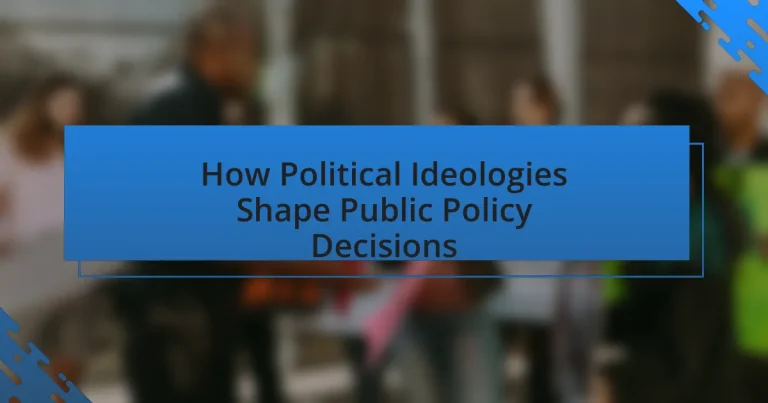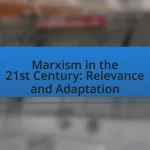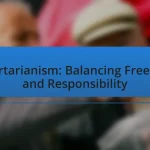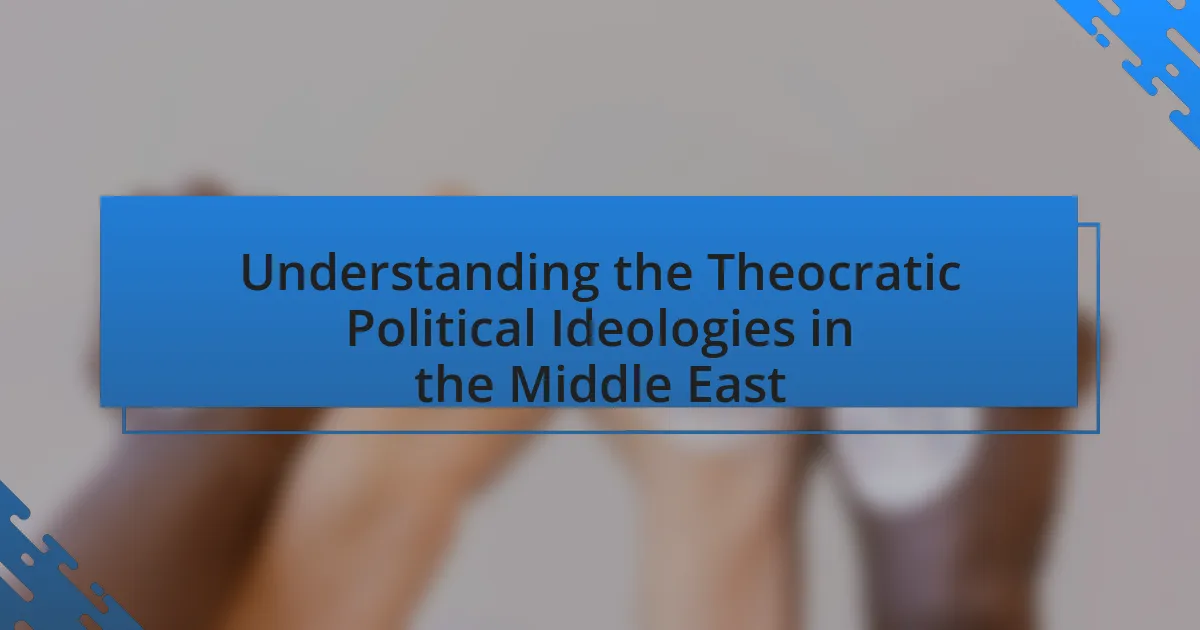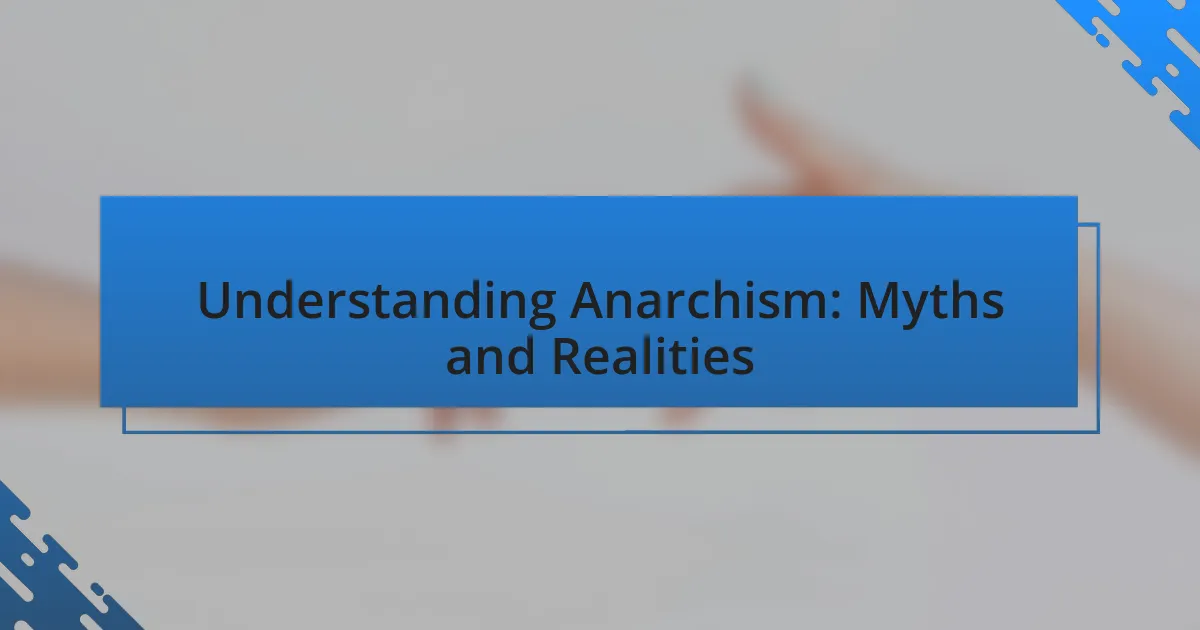Political ideologies play a crucial role in shaping public policy decisions by influencing the priorities and values of lawmakers. This article examines how various ideologies, including liberalism, conservatism, socialism, and libertarianism, guide policy formulation and implementation, affecting areas such as healthcare, taxation, and social welfare. It highlights historical examples, such as the New Deal and Reaganomics, to illustrate the impact of ideological frameworks on governance and public discourse. Additionally, the article discusses the mechanisms through which ideologies influence policy, including lobbying, party platforms, and interest groups, emphasizing the importance of understanding these dynamics for effective policymaking.
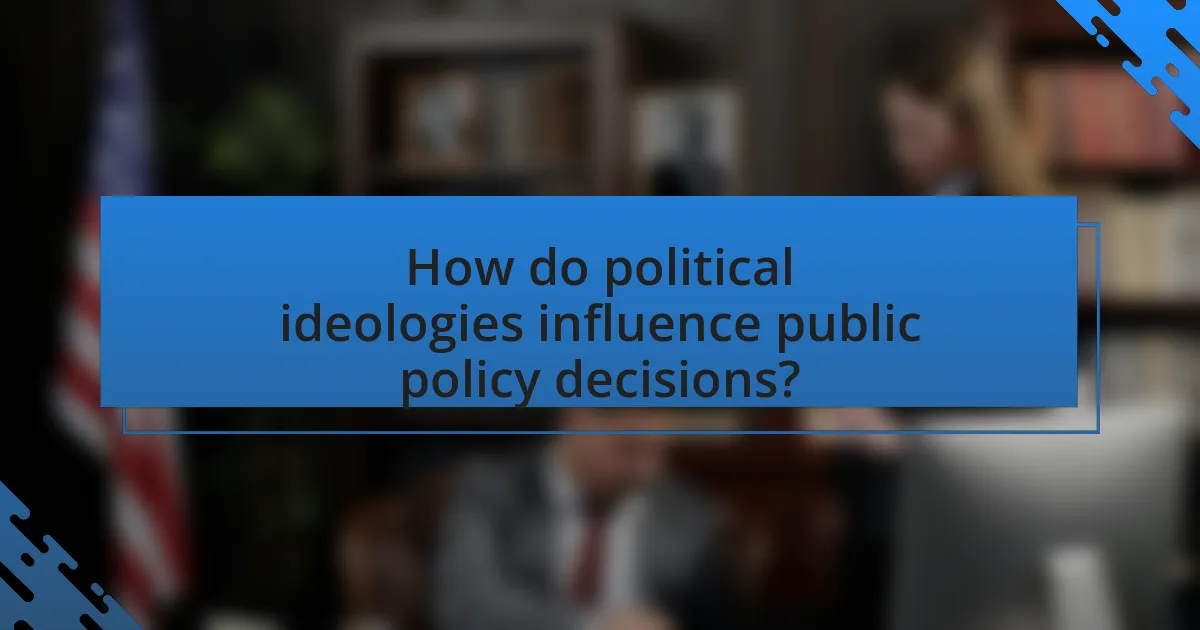
How do political ideologies influence public policy decisions?
Political ideologies significantly influence public policy decisions by shaping the priorities and values that guide lawmakers. For instance, liberal ideologies typically advocate for social equality and government intervention in the economy, leading to policies such as universal healthcare and environmental regulations. In contrast, conservative ideologies emphasize individual responsibility and limited government, often resulting in policies that favor tax cuts and deregulation. Historical examples include the New Deal policies of the 1930s, driven by a progressive ideology aimed at economic recovery, and the Reagan administration’s tax reforms in the 1980s, reflecting conservative principles. These ideological frameworks not only dictate the types of policies pursued but also affect the political discourse surrounding issues, influencing public opinion and voter behavior.
What are the main political ideologies that shape public policy?
The main political ideologies that shape public policy are liberalism, conservatism, socialism, and libertarianism. Liberalism advocates for individual rights and social equality, influencing policies that promote civil liberties and welfare programs. Conservatism emphasizes tradition and stability, often leading to policies that prioritize law and order and fiscal responsibility. Socialism focuses on social ownership and egalitarianism, resulting in policies aimed at wealth redistribution and public services. Libertarianism champions minimal government intervention, shaping policies that protect personal freedoms and limit state power. Each ideology has historically influenced legislative frameworks and governance structures, reflecting the values and priorities of different societal groups.
How do liberal ideologies approach public policy?
Liberal ideologies approach public policy by emphasizing individual rights, social justice, and government intervention to address inequalities. This perspective advocates for policies that promote civil liberties, equal opportunity, and welfare programs aimed at supporting marginalized groups. For instance, liberal policies often support healthcare reform, environmental regulations, and education funding to ensure equitable access to resources. Historical evidence, such as the implementation of the New Deal in the 1930s, illustrates how liberal ideologies have shaped public policy to respond to economic crises and social needs, reinforcing the belief that government has a role in improving societal conditions.
What role do conservative ideologies play in shaping policy?
Conservative ideologies play a significant role in shaping policy by emphasizing limited government, individual liberties, and traditional values. These principles influence legislation and governance, often prioritizing fiscal responsibility, national security, and social stability. For instance, conservative policies frequently advocate for tax cuts and deregulation to stimulate economic growth, as seen in the Reagan administration’s economic policies during the 1980s, which aimed to reduce government intervention in the economy. Additionally, conservative ideologies often shape social policies, promoting family structures and community-based solutions over government programs, reflecting a belief in personal responsibility. This ideological framework has been instrumental in shaping policies related to healthcare, education, and welfare reform, aligning with conservative values that prioritize market solutions and personal choice.
How do socialist ideologies impact public policy decisions?
Socialist ideologies significantly impact public policy decisions by prioritizing social welfare, economic equality, and collective ownership. These ideologies often lead to policies that promote universal healthcare, free education, and extensive social safety nets, reflecting the belief that the government should play a central role in addressing social inequalities. For instance, countries like Sweden and Norway, which embrace socialist principles, have implemented comprehensive welfare systems that provide citizens with access to essential services, funded through progressive taxation. This approach has resulted in lower poverty rates and higher overall quality of life, demonstrating the effectiveness of socialist policies in shaping public welfare outcomes.
Why is understanding political ideologies important for policymakers?
Understanding political ideologies is crucial for policymakers because these ideologies fundamentally shape the values, priorities, and frameworks within which policies are developed and implemented. Policymakers who grasp the nuances of various political ideologies can better anticipate public reactions, align policies with constituents’ beliefs, and navigate the political landscape effectively. For instance, a study by the Pew Research Center indicates that political polarization in the U.S. has increased significantly, with ideological divides influencing public opinion on key issues such as healthcare and climate change. This understanding allows policymakers to craft legislation that resonates with their electorate, ultimately enhancing governance and fostering social cohesion.
How do ideologies affect the priorities of public policy?
Ideologies significantly influence the priorities of public policy by shaping the values and beliefs that guide decision-making processes. For instance, a government led by a liberal ideology may prioritize social welfare programs, environmental protection, and healthcare access, reflecting its commitment to equality and social justice. In contrast, a conservative ideology may emphasize fiscal responsibility, national security, and limited government intervention, leading to policies that focus on tax cuts and deregulation. Historical examples include the New Deal policies of the 1930s, which were driven by progressive ideologies aimed at economic recovery, and the Reagan administration’s tax reforms in the 1980s, which were rooted in conservative principles advocating for free-market solutions. These ideological frameworks not only determine the specific issues that policymakers prioritize but also influence the methods and approaches they adopt in addressing those issues.
What are the implications of ideological conflicts in policy-making?
Ideological conflicts in policy-making lead to polarization, inefficiency, and gridlock in governance. When differing ideologies clash, it often results in a lack of consensus, making it difficult to pass legislation or implement effective policies. For instance, the U.S. Congress has experienced significant legislative gridlock due to partisan ideological divides, particularly evident during budget negotiations and healthcare reforms. This polarization can hinder timely responses to pressing issues, such as climate change or public health crises, ultimately affecting the quality of governance and public trust in institutions.
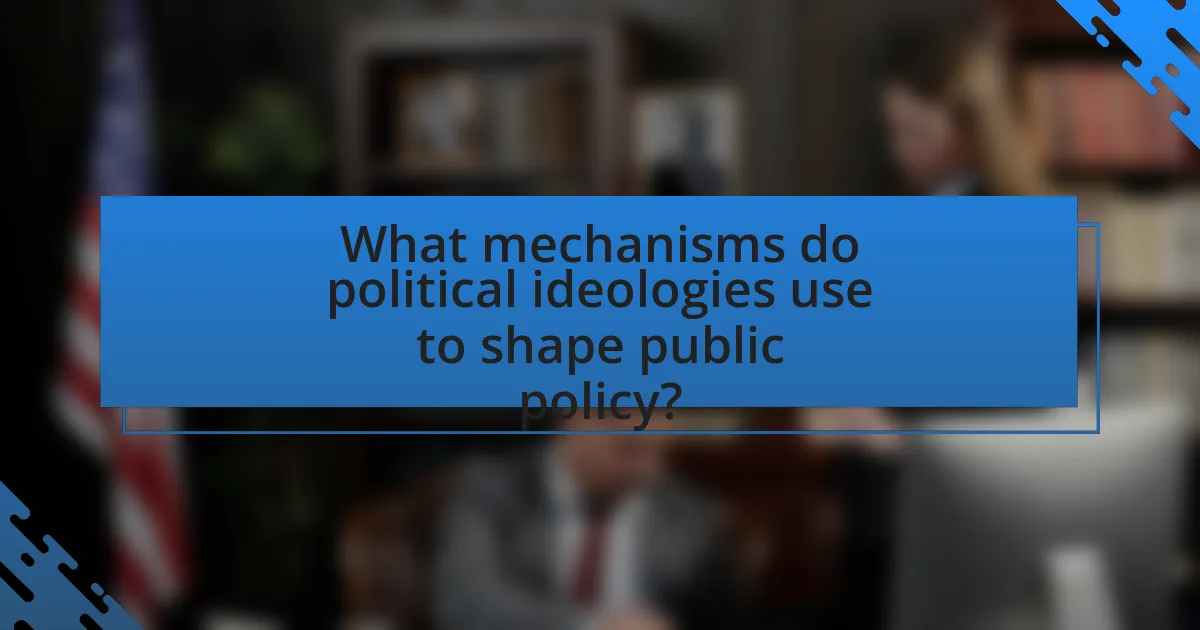
What mechanisms do political ideologies use to shape public policy?
Political ideologies shape public policy through mechanisms such as framing, agenda-setting, and advocacy. Framing involves presenting issues in a way that aligns with specific ideological beliefs, influencing how the public perceives and prioritizes those issues. For example, conservative ideologies may frame economic policies around individual responsibility, while progressive ideologies may emphasize social equity. Agenda-setting determines which issues receive attention and resources, often reflecting the values of the dominant ideology in power. Advocacy, through lobbying and grassroots movements, mobilizes support for policies that align with particular ideological perspectives, as seen in the influence of environmental groups advocating for climate change legislation. These mechanisms collectively guide the formulation, implementation, and evaluation of public policies, ensuring they reflect the underlying values and priorities of the prevailing political ideology.
How do political parties influence policy through ideology?
Political parties influence policy through ideology by promoting specific beliefs and values that shape their legislative agendas. These ideologies guide party members in decision-making processes, affecting the formulation and implementation of policies. For instance, a party with a liberal ideology may prioritize social welfare programs, while a conservative party may focus on tax cuts and deregulation. Historical examples include the New Deal policies of the Democratic Party in the 1930s, which were driven by progressive ideology aimed at economic recovery, and the Reagan administration’s policies in the 1980s, which reflected conservative principles emphasizing free markets and limited government. Such ideological frameworks not only dictate party platforms but also mobilize voter support, thereby directly impacting policy outcomes.
What is the role of party platforms in policy decisions?
Party platforms serve as foundational documents that outline a political party’s principles, values, and policy priorities, guiding decision-making processes. These platforms influence policy decisions by establishing a framework for legislative agendas, shaping candidate positions, and mobilizing voter support around specific issues. For example, the Democratic Party’s platform often emphasizes social justice and healthcare reform, which directly informs their legislative proposals and electoral strategies. In contrast, the Republican Party typically focuses on free-market principles and limited government, affecting their policy initiatives. The alignment of party platforms with public opinion can also enhance electoral success, as seen in various elections where candidates who adhered closely to their party’s platform garnered significant voter support.
How do party leaders and elected officials embody ideological principles?
Party leaders and elected officials embody ideological principles by aligning their policies, rhetoric, and actions with the core beliefs of their political party. For instance, Democratic leaders often advocate for social justice, environmental protection, and healthcare reform, reflecting progressive values, while Republican leaders typically emphasize free-market principles, individual liberties, and limited government intervention, showcasing conservative ideologies. This alignment is evident in legislative agendas, public statements, and campaign strategies, which are designed to resonate with their constituents’ ideological preferences. Historical examples include the New Deal policies under Franklin D. Roosevelt, which embodied progressive ideals, and the Reaganomics approach under Ronald Reagan, which reflected conservative economic principles.
How do interest groups and lobbyists reflect political ideologies?
Interest groups and lobbyists reflect political ideologies by advocating for specific policies that align with their ideological beliefs. These organizations mobilize resources, influence legislation, and shape public opinion to promote their agendas, which often stem from broader ideological frameworks such as conservatism, liberalism, or progressivism. For instance, the National Rifle Association (NRA) embodies a conservative ideology by promoting gun rights and opposing gun control measures, while organizations like Planned Parenthood reflect a liberal ideology by advocating for reproductive rights and healthcare access. This alignment between interest groups and political ideologies is evident in their funding strategies, policy priorities, and the narratives they construct to persuade lawmakers and the public, thereby demonstrating how deeply intertwined these entities are with the ideological landscape of political discourse.
What strategies do interest groups use to promote their ideological agendas?
Interest groups employ various strategies to promote their ideological agendas, including lobbying, grassroots mobilization, public campaigns, and coalition building. Lobbying involves direct interaction with policymakers to influence legislation and regulation, often utilizing expert testimony and research to support their positions. Grassroots mobilization engages the public to advocate for specific issues, leveraging social media and community organizing to amplify their message. Public campaigns utilize advertising and media outreach to shape public opinion and raise awareness about their causes. Coalition building involves forming alliances with other organizations to strengthen their influence and broaden their reach, as seen in movements like environmental advocacy where multiple groups unite for common goals. These strategies are effective in shaping public policy decisions by creating pressure on legislators and raising the visibility of specific ideological perspectives.
How do lobbyists affect the legislative process based on ideology?
Lobbyists influence the legislative process based on ideology by advocating for specific policies that align with their ideological beliefs, thereby shaping the priorities and decisions of lawmakers. For instance, lobbyists representing environmental organizations may push for legislation that promotes renewable energy, reflecting a progressive ideology focused on sustainability. Conversely, lobbyists from the fossil fuel industry may advocate for policies that favor traditional energy sources, aligning with a conservative ideology that prioritizes economic growth and energy independence. Research indicates that lobbyists can significantly sway legislative outcomes; a study by the Center for Responsive Politics found that industries with strong lobbying presence often see favorable legislation passed, demonstrating the power of ideological alignment in lobbying efforts.
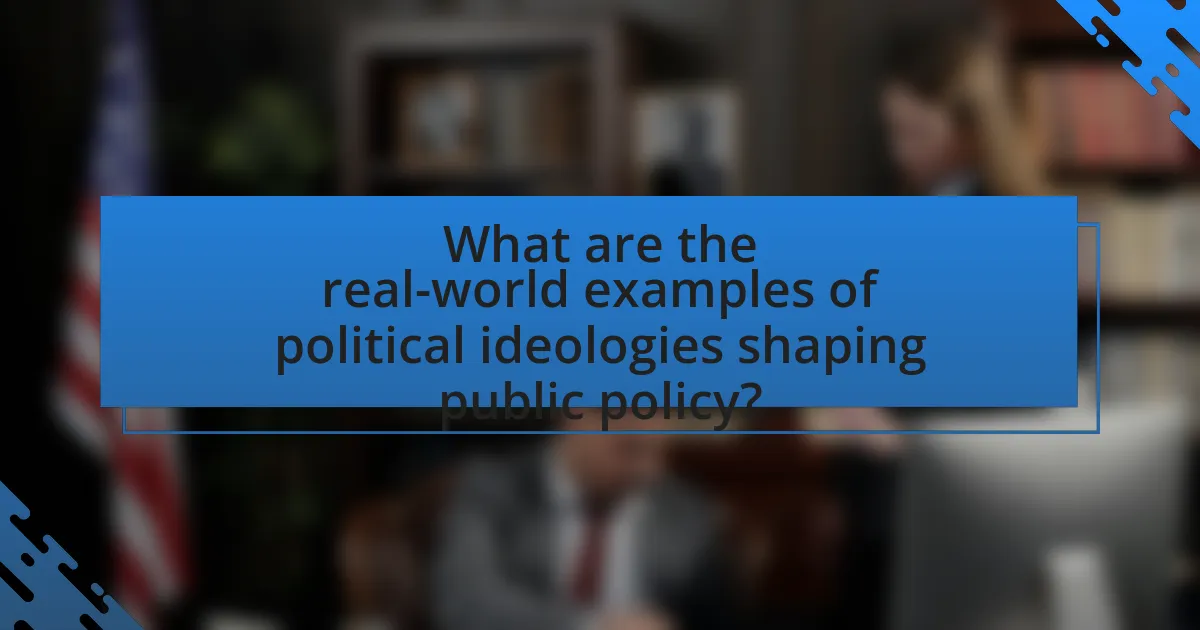
What are the real-world examples of political ideologies shaping public policy?
Political ideologies significantly shape public policy, with notable examples including social democracy in Scandinavian countries and neoliberalism in the United States. In Scandinavian nations like Sweden and Norway, social democracy has led to comprehensive welfare systems, universal healthcare, and strong labor rights, reflecting the ideology’s emphasis on social equity and collective welfare. Conversely, the United States has embraced neoliberalism, particularly since the 1980s, resulting in policies favoring deregulation, tax cuts for the wealthy, and reduced public spending, which align with the ideology’s focus on free markets and individual entrepreneurship. These examples illustrate how distinct political ideologies directly influence the formulation and implementation of public policies in different contexts.
How have liberal ideologies influenced healthcare policy?
Liberal ideologies have significantly influenced healthcare policy by advocating for universal access to healthcare and emphasizing the role of government in providing health services. This influence is evident in the establishment of programs like Medicare and Medicaid in the United States, which were designed to ensure that vulnerable populations receive necessary medical care. Additionally, liberal ideologies promote the idea that healthcare is a fundamental right, leading to policies aimed at expanding coverage, such as the Affordable Care Act, which aimed to reduce the number of uninsured individuals by providing subsidies and expanding Medicaid eligibility. These policies reflect a commitment to social equity and public welfare, aligning with the core tenets of liberal thought that prioritize collective responsibility for health outcomes.
What specific policies reflect liberal values in healthcare?
Specific policies that reflect liberal values in healthcare include universal healthcare coverage, expansion of Medicaid, and the Affordable Care Act (ACA). Universal healthcare coverage aims to provide access to medical services for all citizens, ensuring that healthcare is a right rather than a privilege. The expansion of Medicaid under the ACA allows low-income individuals to gain access to necessary healthcare services, reflecting the liberal belief in supporting vulnerable populations. The ACA itself introduced measures such as prohibiting denial of coverage due to pre-existing conditions and allowing young adults to remain on their parents’ insurance until age 26, both of which align with liberal values of equity and social justice in healthcare access.
How have conservative ideologies shaped tax policy?
Conservative ideologies have shaped tax policy primarily through the promotion of lower taxes and reduced government spending. This approach is rooted in the belief that lower tax rates stimulate economic growth by encouraging investment and consumer spending. For instance, the Reagan administration in the 1980s implemented significant tax cuts, which proponents argue led to increased economic activity and job creation. Additionally, conservative ideologies often advocate for tax policies that favor businesses and high-income earners, reflecting a belief in trickle-down economics, where benefits for the wealthy are expected to eventually benefit the broader economy. This has been evidenced by policies such as the Tax Cuts and Jobs Act of 2017, which reduced corporate tax rates and aimed to incentivize business investment.
What lessons can be learned from historical policy decisions influenced by ideology?
Historical policy decisions influenced by ideology reveal that ideologically driven policies can lead to significant societal outcomes, both positive and negative. For instance, the New Deal policies implemented by Franklin D. Roosevelt during the Great Depression were rooted in progressive ideology, aiming to provide relief and recovery. These policies resulted in a substantial reduction in unemployment and helped stabilize the economy, demonstrating the effectiveness of ideologically motivated interventions in times of crisis. Conversely, the implementation of Prohibition in the United States, driven by moral and religious ideologies, led to increased crime and the rise of organized crime syndicates, illustrating how ideology can sometimes result in unintended negative consequences. These examples underscore the importance of critically evaluating the ideological foundations of policy decisions to anticipate their potential impacts on society.
How did the New Deal reflect ideological shifts in public policy?
The New Deal reflected ideological shifts in public policy by transitioning from a limited government approach to a more interventionist role aimed at economic recovery and social welfare. This shift was characterized by the introduction of programs such as Social Security, the establishment of the Securities and Exchange Commission, and the implementation of the National Industrial Recovery Act, which collectively aimed to provide relief, recovery, and reform during the Great Depression. These policies marked a significant departure from previous laissez-faire principles, demonstrating a belief in the government’s responsibility to actively manage the economy and support its citizens. The ideological shift was further evidenced by the expansion of federal power and the creation of a social safety net, fundamentally altering the relationship between the government and the American public.
What can we learn from the impact of ideological policies on social issues?
The impact of ideological policies on social issues reveals that such policies significantly influence societal norms, behaviors, and outcomes. For instance, research indicates that conservative policies often prioritize individual responsibility and limited government intervention, which can lead to reduced social safety nets and increased inequality, as seen in the United States during the Reagan administration when tax cuts for the wealthy were implemented, resulting in a widening income gap. Conversely, progressive policies tend to emphasize social equity and government involvement, as evidenced by the implementation of universal healthcare in countries like Canada, which has led to improved health outcomes and reduced financial burdens on citizens. These examples illustrate that ideological frameworks not only shape policy decisions but also have tangible effects on the social fabric and quality of life within a society.
What best practices can policymakers adopt to navigate ideological influences?
Policymakers can adopt best practices such as fostering inclusive dialogue, utilizing evidence-based research, and engaging with diverse stakeholders to navigate ideological influences. Inclusive dialogue allows for the consideration of multiple perspectives, which can mitigate the impact of dominant ideologies. Evidence-based research provides a factual foundation for decision-making, reducing the sway of ideology over policy outcomes. Engaging with diverse stakeholders ensures that various viewpoints are represented, promoting balanced policy development. For instance, the use of stakeholder consultations in the development of the Affordable Care Act in the United States demonstrated how incorporating diverse perspectives can lead to more comprehensive and effective policies.
